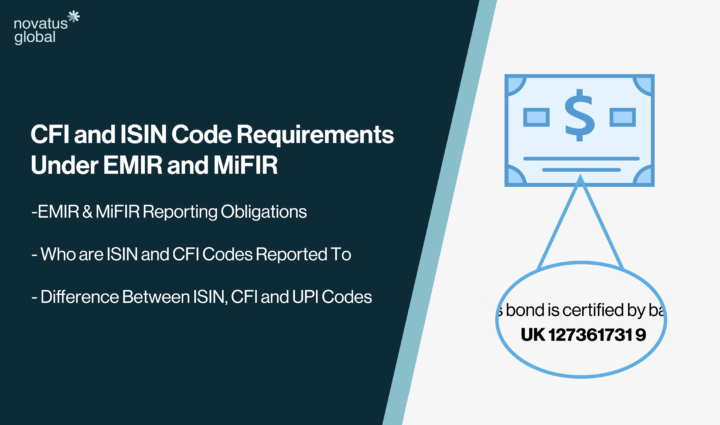
Introduction to CFI and ISIN Codes
The International Securities Identification Number (ISIN) and Classification of Financial Instruments (CFI) codes are essential tools within EMIR and MiFIR reporting. These codes play a critical role in improving the accuracy of data reporting by enabling regulators, counterparties and trade repositories (TRs) to identify and categorise different financial instruments.
The ISIN is a unique 12-character alphanumeric code recognised by the International Standards Organisation (ISO) as a way to identify financial instruments such as stocks and bonds. This ability to identify a specific security is a great tool for ensuring transparency, tracking and efficient reporting across different global markets.
The CFI code is a six-digit code that provides a greater depth of information than an ISIN code. The CFI code is also known as ISO 10962, and describes the structure and function of a financial instrument, providing valuable and insightful data for regulatory reporting

CFI and ISIN – EMIR and MiFIR Reporting Obligations
The European Market Infrastructure Regulation (EMIR) Refit (29 April 2024) introduced updated reporting requirements mandating the use of ISINs for derivative trades on specific regulated venues. These requirements aim to standardise and improve the identification and classification of derivative trades across EU and UK markets.
The Markets in Financial Instruments Regulation (MiFIR) establishes transparency and reporting requirements for derivatives traded on the following types of venues:
-
-
- Regulated Markets (RMs)
- Multilateral Trading Facilities (MTFs)
- Organised Trading Facilities (OTFs)
- Systematic Internalisers (SIs)
-
When a derivative doesn’t meet the conditions for trading on a venue or an SI, and an ISIN is not available, a Unique Product Identifier (UPI) should be used instead. While the UPI serves a similar purpose to an ISIN, it does not contain the same level of granular detail.
Under UK EMIR, as clarified in Article 7 of the Technical Standards on Standards, Formats, Frequency and Methods and Arrangements for Reporting (2023), derivatives must be identified by using an ISIN in the following situations:
-
-
- The derivative is admitted to or traded on a trading venue
- The derivative is traded on an SI, and the underlying asset is either:
-
- admitted to trading or traded on a trading venue
- an index or basket composed of instruments traded on a trading venue
-
-
Any derivatives that do not fall under these conditions should be identified using a UPI, even in situations where an ISIN is available. The UK Financial Conduct Authority (FCA) has clarified that ISINs and UPIs must not be reported together, and prohibits reporting both codes for the same derivative. Validation rules under UK EMIR will reject any submissions that incorrectly include both identifiers for the same derivative. Under the EMIR Refit, UPIs will also be required for OTC derivatives that do not have an ISIN.
Unlike UPIs, CFI codes don’t replace ISINs but complement them by providing a detailed classification of derivatives. According to the FCA, CFIs should be used wherever possible for all derivatives, particularly when the instrument is admitted to trading or traded on a venue or SI.
Under the Markets in Financial Instruments Regulation (MiFIR) and the Markets in Financial Instruments Directive II (MiFID II), ISIN numbers are required to be reported for financial instruments whenever available. When an ISIN is not available, a CFI code must be reported instead, and additional identifying information may need to be reported to ensure classification and compliance.
Who are ISIN and CFI Codes Reported To?
Under the EMIR and MiFIR frameworks, ISIN and CFI codes are reported by firms to authorised Trade Repositories (TRs) as part of their regulatory transaction reporting obligations. TRs are responsible for storing the reported information securely and making it accessible to regulators, including National Competent Authorities (NCAs), for oversight and analysis.
This level of transparency aids information sharing between regulators and is a critical step in mitigating systemic risk. By analysing the reported data, regulators can track market trends, identify potential risks and respond swiftly to emerging threats. The centralisation of this information through TRs is a helpful move towards improving investor confidence, market stability and market integrity.
Key Differences Between CFI, ISIN, and UPI
CFI, ISIN and UPI codes each serve distinct purposes within the regulatory framework of the EMIR Refit. The key differences are as follows:
-
-
- CFI codes – Classification of Financial Instrument
-
- Classify the financial instrument by asset type and characteristics
- Helps regulators to understand the instrument’s structure, issue type and trading conditions
- Provides detailed information to support compliance and oversight
-
- ISIN codes – International Securities Identification Numbers
-
- Uniquely identify financial instruments as a specific type of security such as stocks or bonds
- Globally recognised for tracking, monitoring and managing securities across markets
- Facilitate transparency and enhance standardised reporting across jurisdictions
-
- UPI codes – Unique Product Identifiers
-
- Specifically designed to identify OTC derivative products
- Used for instruments not traded on regulated venues
- Provide a unique identifier for derivates, enabling analysis of OTC market data
-
- CFI codes – Classification of Financial Instrument
-
Best Practices for Reporting CFI and ISIN Codes
Compliance with EMIR and MiFIR / MiFID II regulations is essential for firms, as non-compliance can result in significant monetary and non-monetary penalties. Even minor errors can result in a breach of regulatory compliance, so firms must prioritise accuracy and diligence in their reporting processes.
To ensure compliance, firms should adopt the following best practices:
-
-
- Verify the correct use of CFI codes
-
- Ensure the CFI code reported applies correctly to the instrument used
- Any discrepancies can compromise the validity of the report
-
- Agreement when no CFI exists
-
- If no CFI exists, both counterparties must agree on the correct classification before reporting
- This will prevent reporting errors and prevent validation failures
-
- Establish robust internal processes
-
- Establish and enforce robust internal processes to regularly review and validate reporting requirements
- Processes should include regular checks to ensure compliance with evolving regulatory standards
-
- Stay informed and engage with regulators
-
- Maintain open lines of communication with TRs and regulators
- Stay updated on evolving standards and commit to proactive engagement
-
- Verify the correct use of CFI codes
-
Accurate and compliant reporting of CFI and ISIN codes is critical for firms operating under the regulatory frameworks of EMIR and MiFIR / MiFID II. Adhering to best practices will reduce the potential for errors, avoid costly penalties and contribute to the overall transparency of financial markets.
If you require assistance with any of your regulatory reporting obligations, one of our experts will be happy to explain how Novatus Global can assist. Get in touch today.











